How to Tell if a Valve is Open or Closed (Simple Trick)
Author: Chris Miller | Editor: Omar Alonso
Review & Research: Jen Worst & Chris Miller
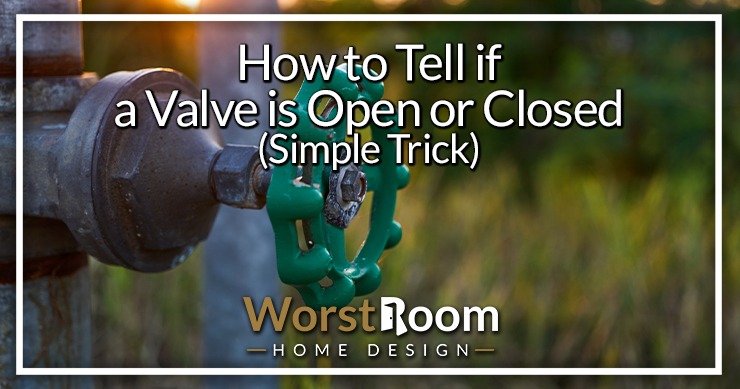
If you had to shut off the water valve to your toilet, would you know how to do it? It's a simple task, but many homeowners have no idea water valves are even a thing, let alone how to tell if a valve is open or closed.
Water valves are all over your property, inside and out. From the bathroom to the kitchen and the garden irrigation system, water valves are an essential feature controlling the flow of this precious resource around your home.
If you have a major leak in the bathroom, you need to know how to shut off the water (or teh opposite if you have no water in your house). This post examines the types of valves commonly found in residential applications and how to tell if a water valve is open.
How to Tell if a Valve is Open or Closed by Valve Type
There are several types of water valves found in and around the home. Here are the most common types, how to identify them, and how to tell if the valve is open or closed.
The key thing to remember is "righty tighty, lefty loosey". This means that in general for most valves that spin, turning to the right will tighten and close it, while turning to the left loosens and opens the passageway.
Another way to think about it is "time is tight", because sometimes the valve will be in a different orientation or can have reverse threading. If you were to position yourself over it (or under it), you would always turn it right. But maybe it's easier to simply remember to always turn it clockwise to tighten/close it.
Ball Valves
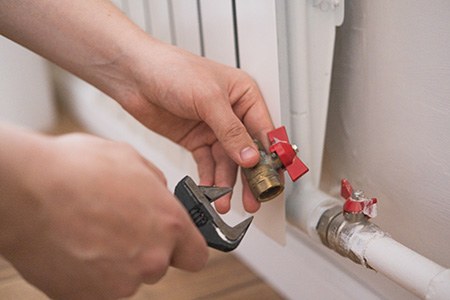
The ball valve is the most common type found in residential applications, such as toilet valves or outdoor faucet types, though the handle may look like that of a gate valve. It's a large steel valve typically featuring a lever-type handle. The design of these valves allows you to turn the water off quickly. All it takes is a ¼-turn of the handle, and the valve moves from the open to the fully closed position.
You can purchase ball valves with standard ports, where the valve has a smaller diameter than the diameter of the pipe. Or you get them in full-port designs where the valve is the same diameter as the pipework. It's an inexpensive, effective, and durable valve, which is why it's popular in residential plumbing.
Ball valves operate through a rotating ball with a hole in the center, allowing water to flow through it when in the open position. When you close the valve, the sphere turns around, blocking water flow through the pipe.
You turn the sphere into the open or closed position using a lever attached to the valve's exterior. The valve handle acts as an indicator, letting you know if it's in the open or closed position.
If the handle is parallel to the pipe, it's open and closed when the handle is perpendicular to the valve. That's how to tell if a ball valve is open or closed: does the handle point along the flow of the water or does it point in the opposite direction across the pipe?
One of the issues with installing ball valves in plumbing applications is that they don't allow control of the water flowing through the valve and pipes. In most instances, they've either fully closed or fully open. However, ball valves are known for providing an effective seal when closed, and they don't leak.
Some people will call this a lever valve because the handle will look like a lever, but we name valves based on how the interior works. But it's the same to tell if a lever valve is open or closed. You can tell by whether it's parallel or perpendicular to the pipe. Those are the valve open and close direction options.
Gate Valves
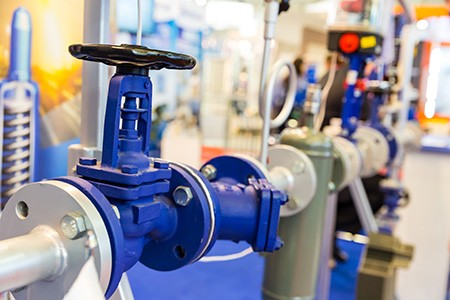
The gate valve is another popular option for residential and commercial applications. These valves usually feature in the home's water mains. The "gate" describes the mechanism responsible for opening and closing the valve.
You'll use a circular handle to open and close the gate valve. When turning the wheel, it lifts or lowers a steel gate inside the valve body. When the valve is in the closed position, the gate blocks the flow of water through the valve body. You can use gate valves to completely shut off the water supply or to reduce flow rates through the valve body.
Typically, these valves are used in major water mains and in the pipes leading to the hot water boiler. They're durable valves, inexpensive, and effective. Some models are more expensive than others, so check around for pricing before buying one.
If you want to close the gate valve, you turn it to the right. When you can't turn it anymore, the valve is fully closed. Since gate valves are common on water mains, if it's in the closed position and you start turning it to the left, you'll feel and hear the water rushing through the valve as you turn the wheel.
The more you turn the wheel to the left, the more it raises the gate in the valve body, increasing water flow. This design gives you the ability to control the amount of water moving through the system. That is how to tell if a gate valve is open or closed.
Over time, these valves will wear out if used frequently and corrode, causing a stuck valve where the gate doesn't want to move. However, when in the fully closed position, the gate valve provides a highly effective seal. Just remember the trick on how to tell if a valve is open or closed.
Butterfly Valves
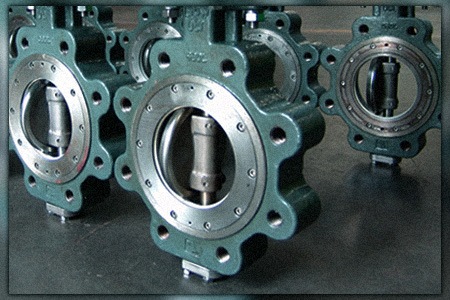
The butterfly valve is another common type used in residential plumbing applications. These valves feature a flat disc in the valve body, pivoting on a centralized pin. Typically, the disc is the same size in diameter as the pipework connecting to it.
Like the ball valve, the disc in the butterfly valve turns to one side, allowing water to pass around it. It also features a handle lever for opening and closing the disc inside the valve body. When the lever is parallel to the valve body, the disc is fully open. When it's perpendicular to the valve body, it's in the fully closed position.
However, the butterfly valve isn't very efficient. The disc is always in the center of the pipeline, taking up space as the water moves around it. So, you'll experience a drop in water pressure in the plumbing if you fit butterfly valves into the system.
While the butterfly valve is less efficient, it also allows for more precise control of the water flow moving through the body, allowing you to adjust the flow rate to your needs. The downside of using butterfly valves is that they sometimes don't close properly in the fully off position. The valve seat might wear, or the disc doesn't seat correctly in the off position, leading to a leak.
You'll find these being used to control the flow of air as a liquid in a lot of tools such as weed eaters, leaf blowers, and many types of lawn mowers. It's useful in fluid dynamics and can create currents and turbulence that have to be taken into account in calculations as well.
Globe Valves

The globe valve resembles a ball valve when looking at its exterior. You'll notice a slightly bulged body, similar to that of a ball valve. These valves are more expensive than ball valves but durable and effective.
Plumbers fit ball valves to systems requiring more control over the flow rate moving through the valve body. These valves offer excellent variable control of flow rates and are typically used in applications like pipework leading to water spigots. However, they can be found anywhere on plumbing systems where there's a shutoff.
A baffle inside the globe valve body features a water flow part running through it. The wheel handle on the valve operates a sealed plunger with a washer on the foot of the plunger. When you close the valve using the handle, it moves the plunger into the fully closed position, pushing it against the water flow port to shut it off.
Like the gate valve, when the wheel is fully turned to the right, the valve is in the fully closed position. When closing the valve, it's common to feel the plunger moving inside the body. The feedback lets you determine how close you are to shutting off the valve.
Angled-Fixture Shutoff Valves
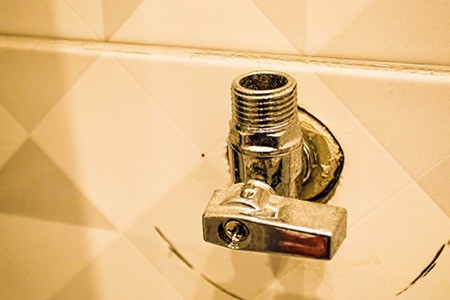
The angled-fixture valve is commonly used in bathrooms and kitchens for connecting the water line to the toilet and taps on the sinks. They come in several models, all with different appearances. Still, the most common type is a small silver or chrome valve with a black, oval-shaped plastic handle and a handle with ribbed edges for easy gripping when opening and closing it.
The angled fixture shutoff valve features in all installations where the water line comes out of the wall around the home. So, you'll usually find it as the valve fixture for washing machines and dishwashers. These valves are ideal for situations where the pipe comes out of the wall and angles straight up, feeding supply tubes to tailpieces, like the toilet or faucets.
They're durable and inexpensive, relying on a compression stem to shut the valve body and stop water flowing. You'll usually notice a squeeze when turning off the valve. Other types of angled-fixture valves use a small ball in the valve body, similar to a ball valve system.
These valves come in different models, allowing them to be solvent-glued onto plastic pipework or braised onto copper pipes. The most common type is a compression fitting, enabling the valve to slip over the pipework and tighten into position.
You'll know it's fully closed when the line on the plastic opening and closing switch is perpendicular to the plumbing line and open when it's in line with the pipe.
Stop-and-Waste Valves
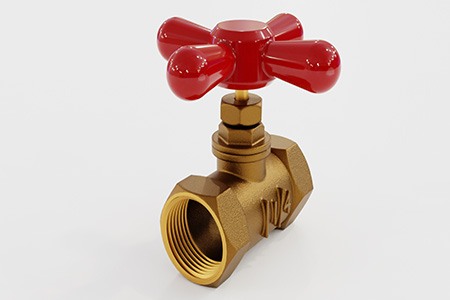
The stop-and-waste valve is a fitting used in irrigation systems in the yard. They control water flow to the lines, ensuring the water doesn't stay in the pipes during the winter, where it freezes and splits the pipework.
The stop-and-waste valve has a metal construction featuring two openings. One opening stops and starts the water flow; the other allows the water to drain from the pipework while preventing more water from entering.
The valve is usually buried just below the soil line in irrigation system applications. You turn it on and off using a specialized key. You won't be able to look at the handle because there likely isn't one. "Righty tighty" or "time is tight" is how to tell if a water valve is open or closed.
When the valve is fully closed, the waste hole opens to drain the line. You'll turn the key to the right to fully close the valve. The stop-and-waste valve is somewhat expensive. However, if it's installed properly, it's a durable fitting.
That’s How to Tell if a Valve is Open or Closed
As you learned about the various types of valves above, you'll have noticed that nearly universally we'll follow the "right tighty, lefty loosey" or "time is tight" rules to close the valve. You will turn a valve to the right (meaning clockwise) to close it and to the left (meaning counter-clockwise) to open it. That is how to tell if a valve is open or closed.



